Winning business is challenging, and no business can thrive without sales. This is a problem in most organizations, because many people hate the idea of having to sell things, and spend their careers avoiding it.
I was one of them. For years I avoided sales work because I associated it with the experiences that I’d had of being sold to by people who sell poorly. Think over-friendly insincere extrovert shouting to be heard over a loud plaid jacket. Will Ferrell as sales guy in a Kubrick film with screenplay by Stephen King. Scary.
So, I’m not a salesperson. Certainly not if that is the template. But as a card-carrying introvert who co-founded a business with a credit card and more hope than good sense, I had to find some buyers for what we were selling. And I needed to find a different approach to selling, because what I was being told was necessary to make sales was not something I would ever excel at.
Below is six years’ worth of thinking about what goes into selling things with the least amount of ‘Selling’ possible. An idiot’s guide to selling, if you will, for those allergic to plaid. I’ve listed out the component parts that I’ve identified in the sales process by the challenge it represents (named at the top of the diagram), and then offered a few thoughts on what solutions to those challenges might look like (the bottom of the diagram).
Sales Challenge: Leading a persuasive sales conversation (in the room/on the telephone with a potential buyer)
This is the part of the sale where buyer and seller explore the buyer’s need, and then what the seller proposes to offer to fill that need. The skills required from the salesperson include questioning, challenging, listening, summarizing, matching, envisioning and persuading. Strangely, the thing that doesn’t work in this part of the sales process is ‘selling’. There is a lot going on, but if done well it just looks like a very interesting conversation.
Critical here is the ability to let go of one’s own sales agenda – at least for a bit – to find out what is important to the potential buyer. For instance, unless they believe they have a problem, you can’t have a solution. Similarly, if you don’t know what they think their problem is, then you can’t present them with possible solutions that they’ll recognize as such.
You have to earn the right to be seen as a potential provider of solutions, and you earn that right by listening – really listening, with no intent to sell – for much longer than you might think.
Solution: SPIN selling, Miller Heiman Conceptual Selling, and pretty much anything that helps the buyer feel his needs and desires are the focal point of the discussion.
Sales Challenge: Talking to people who can actually buy
You can be as good as you like at the skills needed in the room with a client, but if you are not talking to the right people your efforts will be wasted. Prior to getting into a sales conversation we need to consider who needs to be in the room for your listening, challenging and influencing to have the desired impact on the road to a sale.
Solution: There are various ways to do this, but Miller Heiman’s Strategic Selling offers a great way to think through what kind of buyer you are talking to (technical, financial, user, etc), what their concerns might be, and who needs to be in the room for the sale to move forward. Mapping what you do and do not know about the personalities (and the motivations) of those on the buying side won’t give you all the answers, but it will give you great questions to ask of yourself, the client, and your network.
Sales Challenge: Sales ‘Hygiene’
Here it is all about whether you can coordinate action between your team and the client’s team in a timely and reliable manner. All of the sales skills in the world will not help you if you have destroyed your credibility by not sending the follow up documents you said you would, at the time you said you would.
Another way to think about this is that in order for your pipeline to be pushing out sales on a regular basis you need to put a lot more sales opportunities into the pipeline than you want to get out the other end as actual sales. Many of those opportunities only need weekly, monthly or quarterly nurturing to stay alive and still moving through the pipeline, but what I see many people doing is focusing too much on the few opportunities that are near to closing. In doing so they get trapped trying to close things that are not yet ready to close, and can end up driving clients away with their desperation.
You can’t force sales any more than you can force plants to grow, but you can do the work that supports them coming to fruition. Many sales people are inadvertently doing the sales equivalent of pulling on buds to make them bloom because they are only able to manage a small number of opportunities in their system. With the ability to manage a greater number of opportunities through the pipe, one can relax and nurture opportunities safe in the knowledge that they’ll bloom when ready.
Solution: GTD, to not put too fine a point on it. Using GTD consistently has dramatically impacted my ability to sell things over time. Some relatively random suggestions from the methodology that support increased sales:
- Project List: if it is complete, then each potential sale will be listed there. Reviewing each opportunity (at least) once per week and finding the next action keeps things moving through the system
- Waiting for list: if they asked you to send something out and you sent it, then they owe you a response. Tracking all those proposals in your head is good for nothing other than a quick trip to the funny farm
- Bring Forward system: Possible sales die on the vine because the client says ‘not now’, and your system doesn’t allow you to track getting back to them when they said they wanted to start to think about your product or service again
There is much more, but the blog form limits what can usefully be said here so I’ll simply list those three.
Sales Challenge: Creating awareness in the market of the problems you solve, or the product you offer (Marketing…)
In order to get the opportunities into your pipeline, potential customers need to be aware of what it is that you do. In most businesses these days it is simply a ticket to entry to be doing some form of marketing.
Solution: Networking, blogging, social media, attending conferences, speaking at conferences, newsletters, mailings.
Sales Challenge: Who you think you are: Habits, Attitudes, Beliefs, Expectations
This is one of the most powerful pieces of this model, because who you think you are determines the kind of results that you can produce. For sanity, you have to consistently produce the results you believe yourself capable of, because if you don’t then your very identity is in question. We work very, very hard indeed to keep being the person that we believe ourselves to be.
How does that play out in sales? Well, if you feel you are a £1m a year kind of sales person, you will produce that number pretty consistently year after year. To make that possible, you know that you need to be producing something like £83,000 per month to make your target, to be the person you believe yourself to be.
If you have a bad month, and make only £40,000, you’ll get very creative to make more in the months that follow. Unfortunately, if you have a very good month, you’ll take your foot off the gas and probably manage to produce something that looks very much like £1m at the end of the year. We really, really like to be the people we know ourselves to be.
There is no truth here, just your sense of self and your sense of what is ‘right’ for you; where you belong and the kind of people you can talk to, easily. This is an internal dialogue: ‘I’m okay speaking to HR buyers/CFOs, but not to CEOs’. Or, ‘I’m comfortable speaking to CEOs, but only of small businesses’. Wherever it is that you are comfortable, you’ll perform well.
Solution: Working on the sense of self to expand the sense of what is possible, and remove the self-imposed blocks to allow that to happen. Easily said, yes, but also doable with time and application.
What is clear to me now is that what scared me about selling was the first part of this model; being in a room with someone who is either saying ‘no’, or asking difficult questions and making pertinent objections to what I had to sell. What I notice six years later is that the more work one does in the other parts of this model, the less work needs doing in that part of the sales process.
If you get to the sales conversation and have not done a lot of work in the other parts of the model, you’ll end up ‘pushing’, to which there is only ever one response: pushing back. Which gets you the kind of sales arm-wrestling challenge that Will Ferrell lives (and dies) for. It takes all kinds.

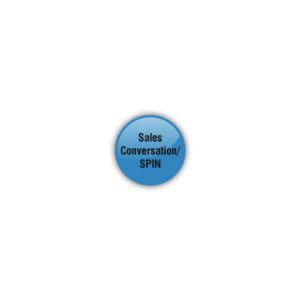
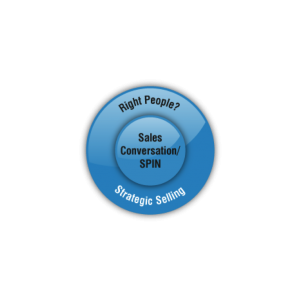
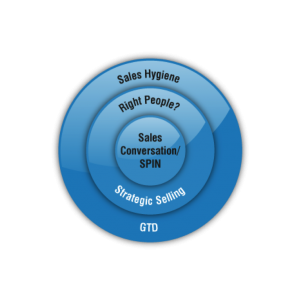
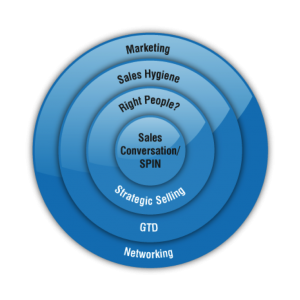
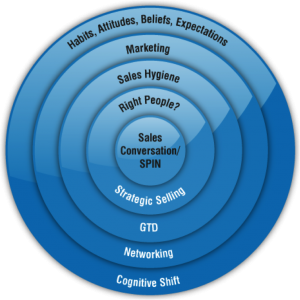

I really like this summary Ed, very consistent with all I have ever heard/read about best practice selling. Unfortunately, I have found too few people selling to me actually follow that process (particularly the “who is the real buyer” bit). The old “Know Can Do” gap.
But I especially like the last bit about the attitude and beliefs of the salesperson themselves, probably the biggest barrier of all. Again, it highlights that changes in behaviour come from the “inside” (who I think I am) not from the outside (the process I know I should follow).